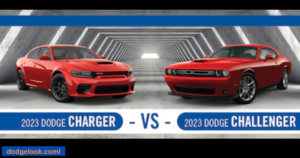The 2025 Dodge Charger EV isn’t just another electric car. It’s a bold leap into the future, blending the raw power of a muscle car with cutting-edge EV tech. If you’ve ever dreamed of roaring down the highway while embracing sustainability, this car might be your perfect match. But it’s not all smooth roads. Some owners worry about security, especially with features like Dodge Charger EV and GPS Tracking. Others feel the high upgrade costs and limited base models hold it back.
Key Takeaways
- The 2025 Dodge Charger EV mixes strong car power with electric tech, giving exciting speed for fans of fast cars.
- The Fratzonic Exhaust System makes real engine noises, keeping the fun of muscle cars in an electric ride.
- High upgrade prices and few base models might upset buyers wanting cheaper choices.
- The Charger EV’s maps and charging tools are old, making long drives and charging harder.
- GPS tracking adds safety and ease, helping owners find their car or get it back if stolen.
The Features That Enthusiasts Love
Performance and Muscle Car Legacy
The Dodge Charger is known for its power and muscle car history. The 2025 Dodge Charger EV keeps that tradition alive. It combines its classic roots with modern electric performance. For example, the Charger Daytona R/T offers more horsepower and instant torque than the older Charger R/T. Here’s a simple comparison:
This mix of EV tech and muscle car spirit gives you thrilling performance. Whether speeding on highways or driving in the city, the Charger EV delivers excitement.
Fratzonic Exhaust System: A Unique Innovation
The Fratzonic Exhaust System is a standout feature of the Charger EV. If you love the roar of muscle cars, this system won’t disappoint. It doesn’t use regular speakers to fake engine sounds. Instead, it uses special tubes to create motor noises as loud as 126 decibels. That’s as loud as the Hellcat, a famous muscle car.
This system isn’t just about sound it’s about keeping the emotional thrill of hearing a car roar. It makes the Charger EV different from other quiet electric cars. With the Fratzonic system, you get the sound of power and the benefits of an EV.
Appeal to EV Adopters and Sustainability Advocates
If you care about the planet but still want speed, the Charger EV is for you. It has features that are both eco-friendly and fun to drive:
Solid-state batteries with over 390 Wh/kg energy density, offering 600+ miles of range.
The Scat Pack model goes from 0 to 60 mph in 3.3 seconds, proving green cars can be fast.
These features show the Charger EV isn’t just about cutting emissions. It’s about showing what electric cars can achieve. You can enjoy fast driving while helping the environment. It’s a win for both speed lovers and eco-conscious drivers.
- The Controversies Surrounding the Charger EV
- High Upgrade Costs and Pricing Transparency
The Charger EV is priced for high-end buyers. But many features cost extra. Want a front trunk? That’s $5,000 more. Heated seats and LED headlights? Also upgrades. Other EVs often include these features for free.
Dealers add their own markups too. High-end Daytona models can bring dealers $3,200 in profit. Markups can even go $10,000 over MSRP. This makes some buyers feel they’re overpaying. If you like clear pricing, this might be frustrating.
Limited Base Model Availability
Getting a base model Charger EV isn’t easy. Dodge focuses on expensive trims, so base models are rare. This helps profits but limits choices for budget buyers.
Base models are a way to own a Dodge EV affordably. They offer muscle car fun without the high price. But with few available, buyers may feel forced to spend more. This can push away those wanting an affordable EV option.
Comparisons with Competitors Like Tesla
When compared to Tesla, the Charger EV has gaps. Tesla’s Model S has sleek looks, autopilot, and great charging options. Dodge is still improving in these areas.
Tesla also has clear pricing. You know what you’re paying for upfront. Dodge’s dealer markups and costly extras feel less simple. If you want ease and clarity, Tesla might seem better.
Weak Navigation and Charging Features
The 2025 Dodge Charger EV struggles with navigation and charging. If you value easy-to-use tech, this could be a problem. Let’s look closer.
Outdated Navigation System
The Charger EV’s navigation isn’t as advanced as expected. It works but lacks the features found in other EVs. For example:
Few Real-Time Updates: Traffic updates aren’t always accurate or helpful. This can leave you stuck when other systems would guide you around delays.
Old-Fashioned Interface: The system feels clunky and hard to use. Simple tasks like finding charging stations or entering addresses can be annoying.
No Smart Features: Unlike Tesla, it doesn’t plan charging stops for you. You’ll need to figure out where to charge on your own.
Charging That Disappoints
Charging the Charger EV isn’t as simple as it should be. Here’s why:
Small Fast-Charging Network: Dodge doesn’t have its own chargers. You’ll rely on third-party networks, which aren’t as reliable as Tesla’s Superchargers.
Slow Charging Times: Even at fast chargers, it takes longer than rivals. Long trips can feel extra slow because of this.
Hard-to-Find Chargers: The car’s system doesn’t always show nearby charging spots. You might need another app to locate them, which adds hassle.
Not Ideal for Road Trips
Road trips with the Charger EV can be tricky. The weak navigation and limited charging options make planning harder. You’ll need to carefully map out stops, which takes away the fun of spontaneous travel.
In summary, while the Charger EV shines in power and looks, its navigation and charging fall short. For a car aimed at the future, these flaws make it feel behind the times.
- Security Concerns and the Role of GPS Tracking
- Real-Life Theft Incidents and Police Response
Car theft is scary and happens to Dodge Charger EV owners. In St. Charles, Missouri, Kim Winston’s Charger was stolen from her parking lot. The car was later found stripped down to its frame. Even though people saw the car several times, police acted slowly. Both St. Louis City and St. Charles Police had trouble working together. Kim waited weeks to get her car back. Stories like this show why strong security features are important.
Dodge Charger EV and GPS Tracking: Enhancing Security
GPS tracking helps protect your car from theft. With built-in GPS, you can see your Charger’s location anytime. If it’s stolen, you’ll know where it is right away. This feature also helps police recover your car faster. It’s like having a 24/7 security guard for your vehicle.
Dodge is adding better GPS tracking to their EVs. This shows they care about stopping theft. While no system is perfect, GPS tracking gives you peace of mind. It also increases the chances of getting your car back quickly.
Benefits of Advanced GPS Features for Owners
Advanced GPS features do more than stop theft. They make driving easier, too. For example:
- Geofencing Alerts: Set areas for your car to stay in. If it leaves, you’ll get a warning.
- Remote Monitoring: Use your phone to see your car’s location anytime.
These features aren’t just about safety—they’re about making life simpler. With Dodge Charger EV and GPS Tracking, you get both security and convenience.
Balancing Legacy and Innovation
Dodge’s Effort to Keep Muscle Car Spirit
Dodge is famous for its muscle cars—big engines and loud sounds. With the Charger EV, they aim to keep that feeling alive while using electric power. One example is the Fratzonic exhaust system, which makes engine-like noises. It’s not just about sound; Dodge wants drivers to feel the same excitement as a gas-powered Charger.
But this change isn’t simple. The electric motor changes how the car drives, and some fans think it’s not the same. Auto expert Karl Brauer says Dodge might lose loyal fans because EVs don’t match the brand’s old image. The big question is: how can Dodge keep its muscle car vibe while going electric?
- Dodge’s focus on power makes switching to EVs harder.
- The Charger EV mixes muscle car style with electric tech, but differences stand out.
- Fans might leave as Dodge moves away from its classic roots.
- Struggles to Meet EV Buyers’ Needs
The EV market is growing fast, and buyers want more than speed. They expect cool tech, long driving range, and easy charging. Dodge is trying to meet these needs, but it’s not there yet. For instance, the Charger EV’s navigation feels old, and its charging network isn’t as good as Tesla’s.
You might love how the Charger EV drives, but it may lack convenience. Buyers want modern features, and Dodge has work to do. Mixing muscle car history with today’s EV demands is tough, and Dodge is still learning how to do it.
What’s Next for Dodge’s Electric Cars?
The future is electric, and Dodge knows it. In 2023, nearly 20% of cars sold worldwide were EVs, with 14 million new ones registered, says the International Energy Agency. Dodge’s parent company is already making more EVs, like Jeep’s Wagoneer S and Gladiator 4xe.
What could be next for Dodge? They might create more EVs that stay true to their muscle car roots. The Charger EV might just be the start. As the market changes, Dodge has a chance to reinvent itself. Will they succeed? Only time will tell.
The 2025 Dodge Charger EV is a car that sparks strong opinions. You might love its bold mix of muscle car heritage and electric innovation, or you might feel frustrated by its high costs and limited features.
As Dodge refines its lineup, the Charger EV stands as a daring experiment. It’s a glimpse into how tradition and modernity can collide—and maybe, find harmony. 🚗⚡
For More Info>>>Visit Here
FAQ
What is the starting price of the 2025 Dodge Charger EV?
The base model starts at around $50,000. However, finding one might be tricky since Dodge prioritizes higher trims. If you’re on a budget, you may need to explore other options or wait for better availability.
How does the Fratzonic exhaust system work?
It uses special tubes to amplify motor sounds, creating a roar similar to traditional muscle cars. This isn’t just for show—it’s designed to keep the Charger EV exciting for fans of loud, powerful vehicles. 🎵
Can I charge the Charger EV at home?
Yes, you can. A Level 2 home charger is your best bet for faster charging. If you don’t have one, a standard outlet works but takes much longer. Installing a home charger makes life easier.
How does the Charger EV compare to Tesla in range?
The Charger EV offers up to 600+ miles on a full charge with its solid-state batteries. Tesla’s Model S, however, provides around 405 miles. If range matters most, the Charger EV has the edge. ⚡
Is the Charger EV good for road trips?
Not really. Its navigation system feels outdated, and charging networks aren’t as reliable as Tesla’s. You’ll need to plan stops carefully. If you love spontaneous travel, this might not be the best choice.









